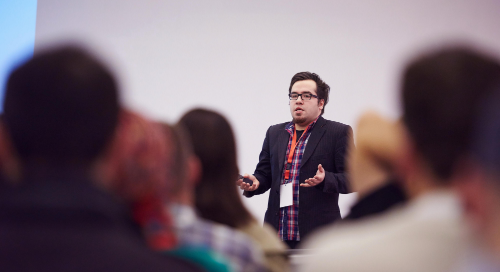cancel-postpone-or-go-virtual-how-associations-are-adapting-the-annual-conference
May 11, 2020
Earlier this spring we faced a decision: Given the impacts of COVID-19, should we cancel the Wiley Society Executive Seminar in London at the end of March, postpone for later in the year, or convert the event into something virtual?
In the end, we decided to do a combination, postponing the full in-person agenda but live broadcasting the keynote address. There is a unique power in being all together in the same room, and depending on the event, it can be worth postponing. For societies facing similar choices with their annual meetings, we wanted to know: How are you making those decisions? So we asked several of our society partners to weigh in.
Cancel, postpone, or go virtual?
Without knowing what the future holds, postponing may mean facing the same decision again in a few months. Anja Sander, Executive Director at the European Academy of Neurology (EAN), shared why they decided to convert EAN’s congress to a virtual event: “Postponement was too unsure, since it’s not clear when a physical congress will be possible again and September and October are full of meetings already.”
And what about the knowledge gap that postponing events could create? Jen Lynch, Publications Director at the Society of Environmental Toxicology and Chemistry (SETAC), explained SETAC’s decision-making process for their upcoming meeting: “The SETAC Europe meetings have been growing year after year, and this year is no exception. We value the scientific contributions from the community, and we wanted to be able to find a way to enable them to present their research.”
What individual associations decide to do is ultimately based on many factors, including public health policies in the original host city, how many attendees are expected and where they’ll be traveling from, and the role that the conference plays in its own discipline community.
What does a virtual society conference look like?
From bite-sized webinars to longer multi-session programs, to online expos that mimic the in-person experience down to virtual auditorium seating and break out rooms, online events run a wide spectrum. “We have been very careful about thinking through the best ways to offer a true best in class virtual experience,” said Rae Ulrich, Senior Director of Integrated Marketing and Brand Strategy at the Institute of Food Technologists (IFT). “That includes looking at every facet of the onsite event and evaluating what would effectively translate to a virtual experience.”
One silver lining to going virtual is that the event is more accessible. “The biggest option for us is the ability to be even more accessible to a broader global audience due to travel and hotel costs not being a barrier to participate,” shared Rae Ulrich from IFT. “It also allows us to share a good portion of the content more easily after the event has concluded, allowing attendees to be able to experience all of the great content the event has to offer.” And, she noted, networking isn’t 100% lost: “There’s also great opportunity for matchmaking and networking because everyone will be participating on the digital platform.”
For SETAC, going virtual is an opportunity to innovate around the traditional 2-dimensional research poster: “Poster presenters are encouraged to include videos, sound bites, or other media to make their work more engaging and interactive, and we look forward to seeing how our presenters adapt their talks to include more than just PowerPoint.”
How should you start planning?
Many organizations are looking to their networks for advice. “We are closely connected with many other medical associations and our industry partners. I recommend getting in contact with all the stakeholders in your field, and listening to their experiences and expectations,” advised Anja Sander at EAN.
Rae Ulrich from IFT also recommended tapping into volunteer and member networks for help, and remembering that “each organization has unique needs that it is trying to fulfill and our experience has shown us there is no single solution, but a combination of integrated solutions to provide a more well-rounded virtual experience.”
And if you’re working on an especially short turnaround? “Coffee!” said Jen Lynch. “Converting an in-person meeting to a virtual event in the span of a month has been a terrific amount of work! More seriously, though, we are not a large society, and a lot of our financial stability is wrapped up in our annual meeting. The Europe staff and leadership surveyed the attendees and had to make a judgment call about whether they would be able to retain a sufficient number of participants to make the move financially feasible. Working with a vendor to help set-up the virtual space incurs additional costs, in a time when cancellations have already been costly.”
Successfully converting large, in-person conferences to virtual events will require society leadership to take a calculated risk, enlisting the help of a vendor or other partner with experience building and hosting online experiences, and listening to feedback from staff and attendees about how virtual programming can best meet their needs and keep the community connected.





